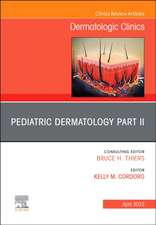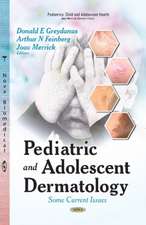Acne – Causes and Practical Management
Autor W Danbyen Limba Engleză Hardback – 29 ian 2015
Acne vulgaris is an extremely common condition. It is troublesome to manage, often persisting into middle age. Exact causes are becoming clear and include several hormonal stimulants, some triggered by the Western diet, and a pathogen ignored for decades. Acnes rosacea and inversa (hidradenitis suppurativa) are discussed from entirely new viewpoints.
Acne: Causes and Practical Managementwill provide readers at all levels with a practical, well–illustrated approach to fully understanding these disorders; a faster and more cost–effective management regimen and the rationales for their prevention.
In full colour throughout and with over 200 excellent clinical images, key highlights include:
- Full coverage of all acne presentations acne vulgaris, acne rosacea and acne inversa (hidradenitis suppurativa)
- An integrated view of the causes of the varied and overlapping acnes
- Preventive, novel and curative approaches to treatment
- Medical, surgical, and dietary components of management, fully integrated
- Highly practical focus on prevention, treatment and prophylaxis based on emerging pathogenetic concepts
Preț: 740.20 lei
Preț vechi: 779.15 lei
-5% Nou
141.68€ • 153.95$ • 119.09£
Carte tipărită la comandă
Livrare economică 21 aprilie-05 mai
Specificații
ISBN-10: 1118232771
Pagini: 256
Dimensiuni: 189 x 246 x 14 mm
Greutate: 0.72 kg
Editura: Wiley
Locul publicării:Chichester, United Kingdom
Public țintă
Primary: dermatologists and dermatology trainees; secondary: general and family practitioners, gynecologists, cosmetic surgeons.Descriere
Learn to accurately diagnose, prevent and treat all three acnes using both traditional and novel approaches to understanding the causes and selecting the most effective treatments.
Acne vulgaris is an extremely common condition. It is troublesome to manage, often persisting into middle age. Exact causes are becoming clear and include several hormonal stimulants, some triggered by the Western diet, and a pathogen ignored for decades. Acnes rosacea and inversa (hidradenitis suppurativa) are discussed from entirely new viewpoints.
Acne: Causes and Practical Management will provide readers at all levels with a practical, well-illustrated approach to fully understanding these disorders; a faster and more cost-effective management regimen and the rationales for their prevention.
In full colour throughout and with over 200 excellent clinical images, key highlights include:
- Full coverage of all acne presentations – acne vulgaris, acne rosacea and acne inversa (hidradenitis suppurativa)
- An integrated view of the causes of the varied and overlapping acnes
- Preventive, novel and curative approaches to treatment
- Medical, surgical, and dietary components of management, fully integrated
- Highly practical focus on prevention, treatment and prophylaxis based on emerging pathogenetic concepts
Brought to you by one of the world’s leading authorities on the subject, Acne: Causes and Practical Management will be a valuable re-education for the dermatologist and all those who treat or suffer from these three conditions.
Textul de pe ultima copertă
"Acne: Causes and Practical Management"
F. William Danby, MD, FRCPC is Adjunct Assistant Professor of Dermatology,
Geisel School of Medicine at Dartmouth, Hanover, New Hampshire, USA.
Learn to accurately diagnose, prevent and treat all three acnes using both traditional and novel approaches to understanding the causes and selecting the most effective treatments.
Acne vulgaris is an extremely common condition. It is troublesome to manage, often persisting into middle age. Exact causes are becoming clear and include several hormonal stimulants, some triggered by the Western diet, and a pathogen ignored for decades. Acnes rosacea and inversa (hidradenitis suppurativa) are discussed from entirely new viewpoints.
"Acne: Causes and Practical Management" will provide readers at all levels with a practical, well-illustrated approach to fully understanding of these disorders, a faster and more cost-effective management regimen and the rationales for their prevention.
In full colour throughout and with over 200 excellent clinical images, key highlights include: Full coverage of all acne presentations - acne vulgaris, acne rosacea and acne inversa An integrated view of the causes of the varied and overlapping acnes Preventive, novel and curative approaches to treatment Medical, surgical, dietary and integrated components of management Highly practical focus on treatment based on emerging pathogenetic concepts
Brought to you by one of the world's leading authorities on the subject, "Acne: Causes and Practical Management" willbe an essentialpurchase for the dermatologist.
Related titles
Practical Psychodermatology
Anthony Bewley, Ruth Taylor, Jason Reichenberg and Michelle Magid
ISBN 9781118560686
Psoriasis: Diagnosis and Management
Wolfram Sterry, Robert Sabat and Sandra Philipp
ISBN 9780470657362
Website
www.wiley.com/go/medicine
Cuprins
Preface ix
Practical acne therapy xii
Genetics xii
Diet xii
Hormones xii
Stress xiii
Comedones (plugs in pores) xiii
Blemishes a brief catalogue xiv
Nodules xv
Scars and sinuses xvi
Support xvii
Introduction xviii
Nomenclature xix
The three acnes and grading xx
Acne vulgaris xx
Acne rosacea xxii
Acne inversa (hidradenitis suppurativa) xxiii
Grading the three acnes xxvi
Acne vulgaris xxvi
Acne rosacea xxvi
Acne inversa (hidradenitis suppurativa) xxvi
1 The three acnes and their impact 1
1.1 Acne vulgaris 1
1.1.1 Terminology 1
1.1.2 The starting point 3
1.2 Acne rosacea 3
1.2.1 The pimply part 4
1.2.2 The redness part 4
1.2.3 The third part the firm fibrosis 6
1.2.4 Part four ocular rosacea 7
1.2.5 Putting it all together 7
1.2.6 The inflammatory epiphenomena in acne rosacea 8
1.2.7 The acne rosacea versus rosacea controversy 12
1.2.8 Summary 12
1.3 Acne inversa (formerly hidradenitis suppurativa) 12
1.3.1 Before the rupture where and why? 15
1.3.2 After the rupture what next? 15
1.3.3 So what invaders are important in acne inversa? 15
1.3.4 What makes this disease behave so much worse than acne vulgaris? 18
1.3.5 So what can one possibly do to settle down all this inflammation? 21
1.3.6 So how do you get rid of all this material? 25
1.3.7 What does the future offer? 25
1.4 The psychology of acne 26
1.4.1 Acne as a stress 26
1.4.2 Acne and self–image 27
1.4.3 Isotretinoin therapy and the psyche 27
1.4.4 The isotretinoin depression question 28
1.4.5 Isotretinoin in perspective 29
2 The folliculopilosebaceous unit the normal FPSU 31
2.1 Anatomy 31
2.2 Genetics 31
2.2.1 Acne vulgaris 31
2.2.2 Acne rosacea 34
2.2.3 Acne inversa/hidradenitis suppurativa (AI/HS) 34
2.2.4 The scottish twins 34
2.3 Epigenetics 35
2.3.1 The farmer s boys 36
2.4 Embryology 36
2.5 Histology 38
2.5.1 Onwards and downwards 38
2.5.2 What is going on inside the FPSU? 40
2.6 Physiology 42
2.6.1 Hair first 42
2.6.2 Oil second 42
2.6.3 Last but definitely not least: the follicle 43
2.6.4 Looking deeper 44
2.7 Biochemistry 44
2.8 Hormones enzymes receptors and the intracrine system 45
2.8.1 The intracrine system 48
2.9 FoxO1 and mTORC1 49
2.9.1 The next step 50
2.9.2 The broad view 51
3 Pathogenetic mechanisms summarized 54
3.1 Acne vulgaris 54
3.2 Acne rosacea 56
3.3 Acne inversa/hidradenitis suppurativa (AI/HS) 57
3.4 Other variants 60
3.4.1 Malassezia folliculitis 60
3.4.2 Eosinophilic pustular folliculitis (ofuji s disease) 62
3.4.3 Dissecting terminal folliculitis 63
3.4.4 Acne keloidalis 63
3.4.5 Epidermal growth factor receptor (EGFR) inhibitor eruption 64
3.4.6 Acné excoriée des jeunes filles 65
4 The acne hormones 67
4.1 The endogenous hormones 67
4.1.1 Androgens and their sources 67
4.1.2 Estrogens and their sources 68
4.1.3 Progesterone and the progesteroids 68
4.1.4 Insulin 69
4.1.5 Growth hormone and insulin–like growth factor–1 72
4.2 The exogenous hormones 72
4.2.1 Anabolic steroids 72
4.2.1.1 Mothers milk 72
4.2.1.2 Muscle makers 74
4.2.2 Oral contraceptive hormones 74
4.2.2.1 Oral estrogens 74
4.2.2.2 Oral progestins 75
4.2.2.3 Extended cycles 75
4.2.3 Other exogenous birth control hormones 77
4.2.3.1 Implants 77
4.2.3.2 Intrauterine devices 78
4.2.3.3 Intravaginal devices 78
4.2.3.4 Topicals: the patches 78
4.2.3.5 Intramuscular (depot) injections 78
4.2.4 Dietary sources of hormones 78
4.2.4.1 The impact of diet on acne 80
4.2.4.2 Carbohydrate load versus dairy load 83
5 Exogenous acnegens and acneform eruptions 87
5.1 Chemicals and medications 87
5.2 Endocrine imitators and disruptors 87
5.2.1 Environmental contamination 88
5.3 Foods 88
5.3.1 Iodine and bromine 89
5.3.2 Chocolate 89
5.3.3 Casein and whey 90
5.4 Photodamage glycation and the acne and aging processes 91
5.5 Smoking and nicotine 91
6 Follicular flora fauna and fuzz 93
6.1 Propionibacterium acnes (P. acnes) 93
6.1.1 Normal role of P. acnes 94
6.1.2 Pathogenic role of P. acnes 94
6.2 Malassezia species 95
6.2.1 Normal role 95
6.2.2 Immunogenicity 97
6.2.3 Pruritogenicity 98
6.2.4 Malassezia in the acnes 98
6.3 Staph strep and Gram–negative organisms 99
6.4 Demodex 99
6.5 Vellus hairs 101
7 The inflammatory response 103
7.1 Innate immunity 103
7.2 Adaptive (acquired) immunity 104
7.3 Inflammation as the primary acnegen 104
7.4 Mediators cellular and humoral and neuroimmunology 105
7.5 Allergy (shared antigens) 106
7.6 Inflammation pigment and PIH 106
7.7 Inflammation and scarring 107
8 Management 109
8.1 Prevention 109
8.2 General principles of management 111
8.3 Diet 111
8.3.1 Dairy 112
8.3.1.1 The deli–planning heiress 114
8.3.1.2 The pharmaceutical executive 115
8.3.2 Carbohydrates glycemic load and hyperinsulinemia 115
8.3.3 The paleolithic diet 116
8.3.4 High–fructose corn syrup (HFCS) 116
8.3.5 Metformin 116
8.3.6 Synthesis and summary 117
8.4 Comedolytics and other topicals 117
8.4.1 Standard topical comedolytics 118
8.4.1.1 Retinoids 118
8.4.1.2 Benzoyl peroxide 119
8.4.1.3 Salicylic acid 120
8.4.1.4 Alpha and beta–hydroxy acids 120
8.4.2 Unclassified topicals 120
8.4.2.1 Azelaic acid 120
8.4.2.2 Sulfur 121
8.4.2.3 Zinc compounds 121
8.4.2.4 Resorcinol 121
8.4.3 Systemic comedolytics 121
8.4.3.1 Vitamin A 121
8.4.3.2 Isotretinoin 121
8.4.3.3 Acitretin 127
8.4.3.4 Summary 128
8.5 Anti–inflammatories and antimicrobials 128
8.5.1 Antibiotics as anti–inflammatories 128
8.5.1.1 In acne vulgaris 128
8.5.1.2 In acne rosacea 129
8.5.1.3 In acne inversa 129
8.5.1.4 In dissecting terminal folliculitis (DTF) and acne keloidalis 129
8.5.2 Antibiotics as antibiotics 130
8.5.3 Ketoconazole ivermectin and crotamiton 130
8.5.3.1 In acne vulgaris 132
8.5.3.2 In acne rosacea 133
8.5.3.3 In acne inversa/hidradenitis suppurativa and dissecting folliculitis and cellulitis 135
8.5.4 Steroids 135
8.5.4.1 The marine 136
8.5.5 Nonsteroidal anti–inflammatory drugs (NSAIDs) and biologics 137
8.5.6 Phototherapy 137
8.5.7 Post–inflammatory hyperpigmentation 138
8.5.7.1 Prognosis 141
8.6 Hormone manipulations and therapy 141
8.6.1 Birth control pill selection 141
8.6.1.1 Estrogens 142
8.6.1.2 Progestins 143
8.6.2 Androgen receptor blockade 143
8.6.2.1 Spironolactone 144
8.6.2.2 Cyproterone acetate 146
8.6.2.3 Flutamide 146
8.6.2.4 Drospirenone 146
8.6.2.5 Topical androgen blockers 147
8.6.3 Dihydrotestosterone minimization 147
8.6.3.1 Finasteride 147
8.6.3.2 Dutasteride 147
8.6.3.3 Diet 148
8.6.4 Phototherapy hormone interactions 149
8.7 Surgery 150
8.7.1 Acne vulgaris 150
8.7.1.1 Acne surgery for patients 150
8.7.1.2 Acne surgery for physicians 151
8.7.2 Acne rosacea 152
8.7.3 Acne inversa/hidradenitis suppurativa 153
8.7.3.1 Mini–unroofing by punch biopsy 153
8.7.3.2 Unroofing 154
8.7.3.3 Wide surgical excision 157
8.7.3.4 Healing options 158
8.8 Lights and lasers 162
8.8.1 Light and other radiation in acne 162
8.8.1.1 Radiation s targets 163
8.8.1.2 Light as a practical acne therapy 164
8.8.2 Lasers 165
9 Acne in pregnancy 171
9.1 Epidemiology 171
9.2 Pathogenesis 172
9.3 Team up with mother nature 173
9.4 Targeting therapy 173
9.4.1 Clinical manifestations 173
9.4.2 Pathology 173
9.4.3 Diagnostic evaluation 173
9.4.4 Overview and general approach to treatment 174
9.4.5 Milk and pregnancy 174
9.4.6 Active therapy 175
9.4.6.1 Avoidance of harm 175
9.4.6.2 Lesion–directed therapy 177
9.4.6.3 Nonprescription topicals 177
9.4.6.4 Antimicrobials 177
9.4.6.5 Combination topicals 178
9.4.6.6 Anti–inflammatories 178
9.4.6.7 Hormone blockers 178
9.4.6.8 Procedural therapies 179
9.5 Discussion 179
9.6 Summary and conclusion 179
10 Putting it all together 182
10.1 Lifestyle choices and the acnes 182
10.1.1 The processed cheese queen 184
10.2 Therapeutic choices and the acnes 184
10.2.1 Acne vulgaris 184
10.2.2 Acne rosacea 185
10.2.3 Acne inversa/hidradenitis suppurativa 185
10.3 Conclusion 186
11 Appendices 187
11.1 Appendix A: the rosacea classification and staging controversy 187
11.2 Appendix B: the dairy versus carbohydrate controversy 189
12 The handouts 193
12.1 Acne 194
12.2 The zero–dairy diet 197
12.3 The risks and benefits of isotretinoin 199
12.4 The paleo diet 204
12.5 Acne inversa/hidradenitis suppurativa (AI/HS) 209
12.6 Yasmin/Ocella/Zarah or Yaz/Gianvi extended cycle for acne therapy 213
Index 215
Notă biografică
F. William Danby, MD, FRCPC is Adjunct Assistant Professor of Dermatology, Geisel School of Medicine at Dartmouth, Hanover, New Hampshire, USA.



















